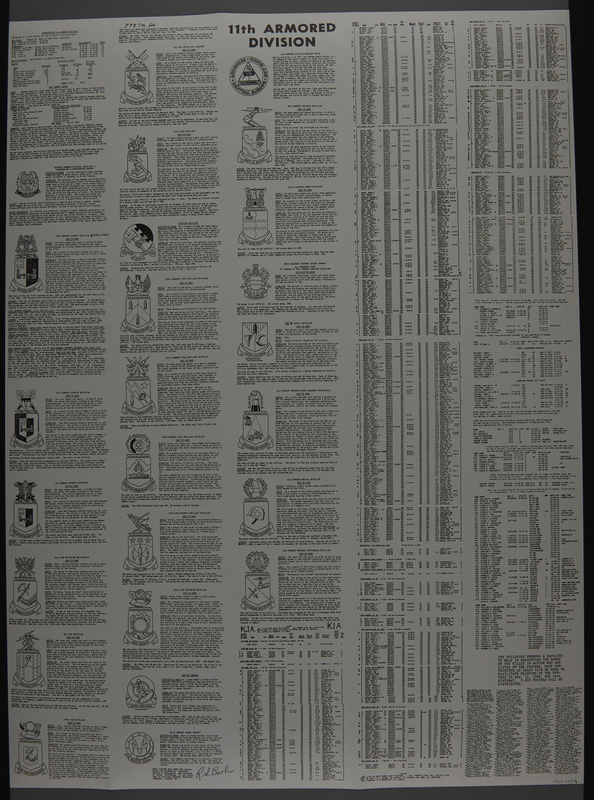Overview
- Brief Narrative
- Commemorative poster for the 11th Armored Division, printed in honor of the division’s 46th birthday on August 15, 1988. It features the names of those who helped pay for the posters, as well as line drawings of the badges, shields, crests, and symbols of the various units that comprised the division, and memorializes the names of those killed in action. The poster was created by division historian Raymond (Ray) S. Buch, and heraldic artist Richard M. Crossett. Both men belonged to the 56th Armored Engineer Battalion, which entered combat in December 1944, during the Battle of the Bulge. On May 5, 1945, Ray and his platoon were near Linz, Austria, when another subgroup of the 11th AD found Mauthausen concentration camp and its former subcamp, Gusen. Soon after, Ray accompanied the bulldozer operators to Mauthausen to assist with the cleanup. While in the camp, Ray was able to film and photograph the scene, documenting the overcrowded barracks, the mass burials and the emaciated prisoners who were either clothed in rags or naked. After about 30 days, the 11th AD left Mauthausen and remained on occupation duty until they were inactivated on August 31, 1945.
- Artwork Title
- 11th ARMORED DIVISION
- Date
-
commemoration:
1942 August 15-1945 August 31
creation: 1985-1988
publication/distribution: 1988
- Geography
-
manufacture:
Linden (N.J.)
- Credit Line
- United States Holocaust Memorial Museum Collection, Gift of Raymond S. Buch
- Markings
- front, top center, printed, black ink : 11th ARMORED DIVISION
front, top right corner, printed, black ink : THIS LIST OF NAMES ARE OF ACTIVE 11th ARMORED VETERANS ,FAMILIES AND FRIENDS. / THEY HAVE PAID FOR THE PRINTING AND HAVE HELPED MAILING THEM LATER. MANY OF / THEM HAVE HELPED IN THE REBUILDING OF THE HQS. IN PITTSTOWN, N.J. AFTER FIRE. / LIST OF NAMES ARE FROM ALL OVER THE U.S.A., AND REST OF WORLD / THE NUMBER FOLLOWING THE NAMES ARE THE ZIP CODE OF CURRENT ADDRESS.
back, top center, printed, black ink : 11th ARMORED / DIVISION
back, first column, section headers, printed, black ink : HEADQUARTERS 11th ARMORED DIVISION / ELEVENTH ARMORED DIVISION, WORLD WAR II / HEADQUARTERS & HEADQUARTERS COMPANY / 55th ARMORED INFANTRY BATTALION [& REGIMENT] / 21st ARMORED INFANTRY BATTALION / 63d ARMORED INFANTRY BATTALION / 41st TANK BATTALION AND REGIMENT / 22d TANK BATTALION / 778th TANK BATTALION
back, second column, section headers, printed, black ink : 42D TANK BATTALION & REGIMENT / 713th TANK BATTALION / DIVISION ARTILLERY / 490th ARMORED FIELD ARTILLERY BATTALION / 491st ARMORED FIELD ARTILLERY BATTALION / 492nd ARMORED FIELD ARTILLERY BATTALION / 575th ANTIAIRCRAFT ARTILLERY BATTALION / 705th TANK DESTROYER BATTALION / SERVICE COMPANY / 151st ARMORED SIGNAL COMPANY
back, third column, section headers, printed, black ink : 11th ARMORED DIVISION SHOULDER PATCH / 56th ARMORED ENGINEER BATTALION / 277th ENGINEER COMBAT BATTALION / 995th ENGINEER TREADWAY BRIDGE COMPANY / ALL PERSONNEL FROM / “E” COMPANY OF 56th ARMORED ENGINEER BATTALION / [16TH] SUPPLY BATTALION / 41st CAVALRY RECONNAISSANCE SQUADRON (MECHANIZED) / 81st ARMORED MEDICAL BATTALION / 133d ARMORED ORDNANCE MAINTENANCE BATTALION
back, second column, bottom, printed, black ink : THIS POSTER HAS BEEN THE BRAIN- / CHILD OF RICHARD M. CROSSETT, / ARTIST & HERALDIST, AND RAYMOND / S. BUCH, HISTORIAN. IT WAS PRIN- / TED BY WILLIAM DRUCKER PRINTING / COMPANY, LINDEN, NJ - Contributor
-
Subject:
Raymond S. Buch
Producer: Raymond S. Buch
Artist: Richard M. Crossett
Printer: William Drucker Printing Company
- Biography
-
Raymond (Ray) Buch (1920-2010) was born in New York City to Ukrainian immigrants, Ludwig (1893-1962) and Mary (nee Straub, 1896-1939) Buch, and was raised on a farm in New Jersey. Ray had four siblings: June (1925-c. 2005), Mary (b.1930), Gloria (1932-2002), and Francis (1934-2011). After completing high school, Ray worked as a construction carpenter until he was drafted into the United States Army in 1942. Ray’s construction background led to his assignment in the 11th Armored Division’s (AD) 56th Armored Engineer Battalion. He went through training in Louisiana and Texas before being deployed to Great Britain in September 1944. His unit arrived in France on December 16, 1944, and went into combat in Belgium during the Battle of the Bulge. Ray was injured during this campaign, and was awarded the Purple Heart. The division continued across Europe to the Siegfried Line, the defensive line on the western border of Germany. The engineers were responsible for a variety of tasks to facilitate movement of the troops, including preparing roads, removing obstacles, building bridges, and clearing mines. Within the 2nd Platoon of Company A, Ray was one of the men who operated the mine detector equipment.
In March 1945, the 11th AD entered the Rhineland campaign in Germany. In mid-April, Ray and his unit began encountering camp prisoners who were being force marched by SS guards. The guards fled, leaving behind a trail of corpses who died or were killed during the marches. Ray’s platoon was part of the 11th AD’s Combat Command A which was moving toward Linz, Austria. On May 5, they were removing dynamite from a bridge when Combat Command B liberated Mauthausen concentration camp and its former subcamp, Gusen. Ray and his platoon were still near Linz when Germany surrendered to the Allies. The war officially ended on May 9. The next day, Ray accompanied the bulldozer operators to Mauthausen to assist with the cleanup. While in the camp, Ray was able to film and photograph the scene, documenting the overcrowded barracks, the mass burials and the emaciated prisoners who were either clothed in rags or naked. The division was at Mauthausen for about 30 days before they were relieved by the 26th Infantry. Prior to their departure, the 11th began burning some of the buildings and backfilled the latrines and mass grave trenches.
After Ray and his unit left Mauthausen, they were sent to Schwanenstadt to maintain roads and rebuild bridges. He also spent a few days guarding the prisoners in Ebensee, a former concentration camp converted to house SS prisoners, and was later sent to the former Dachau concentration camp in Germany. The division remained on occupation duty until they were inactivated on August 31, 1945
Ray returned to New Jersey after the war and went to work as a home contractor. He married Mary Louise Stout (1928-2006) in April 1951, and the couple had two children. Ray led the New Jersey chapter of the 11th Armored Division Association, became a unit historian, and served as the association President in 1974.
Richard McNamee Crossett (1926-2006) was born in Little Rock, Arkansas to Jesse (1893-1974) and Agnes (nee Dowden, 1899-1977) Crossett. Richard was living in Salt Lake City, Utah, when he was drafted into the United States Army in August 1944. Richard was assigned to the 56th Armored Engineer Battalion (AEB), of the 11th Armored Division. While deployed in Europe, the engineers were responsible for a variety of tasks to facilitate movement of the troops, including preparing roads, removing obstacles, building bridges, and clearing mines. The 56th AEB was deployed to Great Britain in September 1944, arrived in France on December 16, 1944, and went into combat in Belgium during the Battle of the Bulge. The division continued across Europe to the Siegfried Line, the defensive line on the western border of Germany. In March 1945, the 11th AD entered the Rhineland campaign in Germany. In mid-April, they began encountering camp prisoners who were being force marched by SS guards. The guards fled, leaving behind a trail of corpses who died or were killed during the marches. On May 5, Combat Command B, which included a group from the 56th AEB, liberated Mauthausen concentration camp and its former subcamp, Gusen. The war officially ended on May 9. The division was at Mauthausen for about 30 days before they were relieved by the 26th Infantry. Before leaving, the 11th began burning some of the buildings and backfilled the latrines and mass grave trenches. The division remained on occupation duty until they were inactivated on August 31, 1945. Richard returned to the United States in June 1946, and enrolled at the University of Arkansas to study commercial art. In 1948, he married Maurine McArthur. After completing school, they settled in Salt Lake City, where he worked as a graphic designer and later became vice president of an advertising agency. Richard also served in the army during the Korean War (1950-1953). Richard and Maurine had four children, and in 1962, moved to Louisville, Kentucky. Richard became a well-known heraldic artist, and belonged to The American College of Heraldry and The Society of Heraldic Arts.
Physical Details
- Language
- English
- Classification
-
Posters
- Category
-
Commemorative posters
- Object Type
-
Posters, American (lcsh)
- Genre/Form
- Posters.
- Physical Description
- Poster printed on a sheet of glossy, white, rectangular paper featuring three columns, each subdivided into three smaller columns of black printed text. The text is separated into blocks for each division unit, listing a series of names followed by five-digit numbers. The poster title is printed in black, block text at the top center. In the top right corner is a description of the text contents, above line drawings of a circular division logo and a coat of arms separated by a small block of text. The back of the poster is printed in black ink, and arranged in five columns. The left column consists of a description of the division statistics and seven blocks of text accompanied by a line drawing of each unit’s coat of arms. The text describes each unit’s coat of arms, the symbolism, and the unit history. The second column consists of 10 descriptions. The center column contains the information of the final eight units, while the bottom begins a list of men labeled as killed-in-action or as prisoners-of-war, along with several smaller columns of data. The list continues through the fourth and fifth columns. At the bottom of the fifth column is a four-columned list of financial donors.
- Dimensions
- overall: Height: 24.000 inches (60.96 cm) | Width: 18.000 inches (45.72 cm)
- Materials
- overall : paper, ink
- Inscription
- back, second column, bottom, printed, black ink : R.S. Buch
Rights & Restrictions
- Conditions on Access
- No restrictions on access
- Conditions on Use
- No restrictions on use
Keywords & Subjects
- Topical Term
- Ardennes, Battle of the, 1944-1945. Combat. Engineers. Mass burials--1940-1950. Soldiers--American. War photographers. World War, 1939-1945--Campaigns--Ardennes. World War, 1939-1945--Campaigns--Europe, Central. World War, 1939-1945--Campaigns--Rhine River Valley. World War, 1939-1945--Concentration camps--Liberation. World War, 1939-1945--Europe--End. World War, 1939-1945--Veterans--United States.
- Geographic Name
- Europe. Linden (N.J.) Upper Austria (Austria)
Administrative Notes
- Legal Status
- Permanent Collection
- Provenance
- The poster was donated to the United States Holocaust Memorial Museum in 1989 by Raymond S. Buch.
- Funding Note
- The cataloging of this artifact has been supported by a grant from the Conference on Jewish Material Claims Against Germany.
- Record last modified:
- 2023-08-25 16:17:47
- This page:
- https://collections.ushmm.org/search/catalog/irn522147
Also in Raymond S. Buch collection
The collection consists of posters, documents, photographs, pamphlets, and newspaper clippings relating to the experiences of Raymond S. Buch in Europe during World War II.
Date: 1933-1986
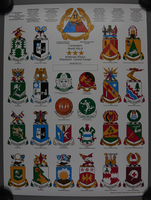
US Army 11th Armored Division two-sided commemorative poster, owned by a unit veteran
Object
Commemorative poster for the 11th Armored Division (AD), printed in honor of the division’s 46th birthday on August 15, 1988. It features colored depictions of the badges, shields, crests, and symbols of the various units that comprised the division, and memorializes the names of those killed in action. The poster was created by division historian Raymond (Ray) S. Buch, and heraldic artist Richard M. Crossett. Both men belonged to the 56th Armored Engineer Battalion, which entered combat in December 1944, during the Battle of the Bulge. On May 5, 1945, Ray and his platoon were near Linz, Austria, when another subgroup of the 11th AD found Mauthausen concentration camp and its former subcamp, Gusen. Soon after, Ray accompanied the bulldozer operators to Mauthausen to assist with the cleanup. While in the camp, Ray was able to film and photograph the scene, documenting the overcrowded barracks, the mass burials and the emaciated prisoners who were either clothed in rags or naked. After about 30 days, the 11th AD left Mauthausen and remained on occupation duty until they were inactivated on August 31, 1945.
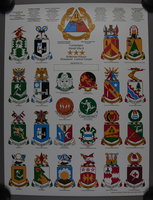
US Army 11th Armored Division two-sided commemorative poster, owned by a unit veteran
Object
Commemorative poster for the 11th Armored Division (AD), printed in honor of the division’s 46th birthday on August 15, 1988. It features colored depictions of the badges, shields, crests, and symbols of the various units that comprised the division, and memorializes the names of those killed in action. The poster was created by division historian Raymond (Ray) S. Buch, and heraldic artist Richard M. Crossett. Both men belonged to the 56th Armored Engineer Battalion, which entered combat in December 1944, during the Battle of the Bulge. On May 5, 1945, Ray and his platoon were near Linz, Austria, when another subgroup of the 11th AD found Mauthausen concentration camp and its former subcamp, Gusen. Soon after, Ray accompanied the bulldozer operators to Mauthausen to assist with the cleanup. While in the camp, Ray was able to film and photograph the scene, documenting the overcrowded barracks, the mass burials and the emaciated prisoners who were either clothed in rags or naked. After about 30 days, the 11th AD left Mauthausen and remained on occupation duty until they were inactivated on August 31, 1945.
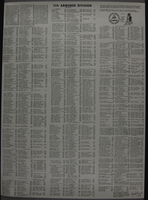
US Army 11th Armored Division two-sided commemorative poster, owned by a unit veteran
Object
Commemorative poster for the 11th Armored Division, printed in honor of the division’s 46th birthday on August 15, 1988. It features the names of those who helped pay for the posters, as well as line drawings of the badges, shields, crests, and symbols of the various units that comprised the division, and memorializes the names of those killed in action. The poster was created by division historian Raymond (Ray) S. Buch, and heraldic artist Richard M. Crossett. Both men belonged to the 56th Armored Engineer Battalion, which entered combat in December 1944, during the Battle of the Bulge. On May 5, 1945, Ray and his platoon were near Linz, Austria, when another subgroup of the 11th AD found Mauthausen concentration camp and its former subcamp, Gusen. Soon after, Ray accompanied the bulldozer operators to Mauthausen to assist with the cleanup. While in the camp, Ray was able to film and photograph the scene, documenting the overcrowded barracks, the mass burials and the emaciated prisoners who were either clothed in rags or naked. After about 30 days, the 11th AD left Mauthausen and remained on occupation duty until they were inactivated on August 31, 1945.
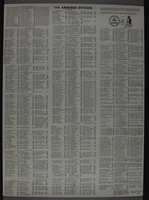
US Army 11th Armored Division two-sided commemorative poster, owned by a unit veteran
Object
Commemorative poster for the 11th Armored Division, printed in honor of the division’s 46th birthday on August 15, 1988. It features the names of those who helped pay for the posters, as well as line drawings of the badges, shields, crests, and symbols of the various units that comprised the division, and memorializes the names of those killed in action. The poster was created by division historian Raymond (Ray) S. Buch, and heraldic artist Richard M. Crossett. Both men belonged to the 56th Armored Engineer Battalion, which entered combat in December 1944, during the Battle of the Bulge. On May 5, 1945, Ray and his platoon were near Linz, Austria, when another subgroup of the 11th AD found Mauthausen concentration camp and its former subcamp, Gusen. Soon after, Ray accompanied the bulldozer operators to Mauthausen to assist with the cleanup. While in the camp, Ray was able to film and photograph the scene, documenting the overcrowded barracks, the mass burials and the emaciated prisoners who were either clothed in rags or naked. After about 30 days, the 11th AD left Mauthausen and remained on occupation duty until they were inactivated on August 31, 1945.
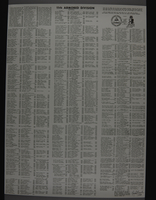
US Army 11th Armored Division two-sided commemorative poster, owned by a unit veteran
Object
Commemorative poster for the 11th Armored Division, printed in honor of the division’s 46th birthday on August 15, 1988. It features the names of those who helped pay for the posters, as well as line drawings of the badges, shields, crests, and symbols of the various units that comprised the division, and memorializes the names of those killed in action. The poster was created by division historian Raymond (Ray) S. Buch, and heraldic artist Richard M. Crossett. Both men belonged to the 56th Armored Engineer Battalion, which entered combat in December 1944, during the Battle of the Bulge. On May 5, 1945, Ray and his platoon were near Linz, Austria, when another subgroup of the 11th AD found Mauthausen concentration camp and its former subcamp, Gusen. Soon after, Ray accompanied the bulldozer operators to Mauthausen to assist with the cleanup. While in the camp, Ray was able to film and photograph the scene, documenting the overcrowded barracks, the mass burials and the emaciated prisoners who were either clothed in rags or naked. After about 30 days, the 11th AD left Mauthausen and remained on occupation duty until they were inactivated on August 31, 1945.
Raymond S. Buch papers
Document
The papers consist of documents, photographs, pamphlets, and newspaper clippings related to the U.S. Army's 11th Armored Division and the liberation of Mauthausen concentration camp.


